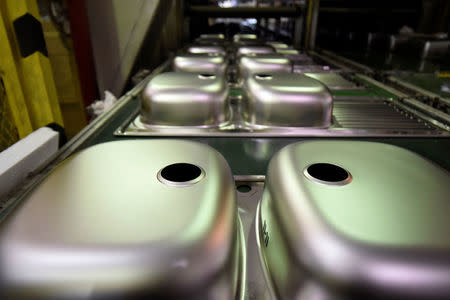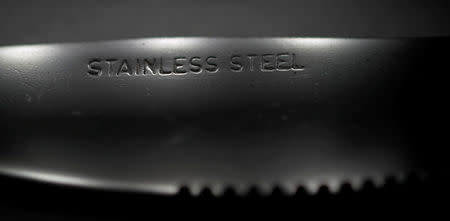Graphic - Stainless steel glut builds in China as Indonesia ups output
By Maytaal Angel
LONDON (Reuters) - An abundance of stainless steel in China following the ramp up of new production in Indonesia is threatening stainless mills globally and the nickel producers that supply them.
Marking a major structural shift, China, which makes and consumes around half of the world's stainless, became a marginal net importer of hot-rolled stainless coil in December for the first time in more than seven years, data from the International Steel Statistics Bureau and from consultants CRU showed.
This is after Chinese-owned stainless giant Tsingshan started production last August at a giant plant in Indonesia that should, by the end of 2018, have an annual capacity of 3 million tonnes.This is equivalent to 6 percent of last year's global flat stainless capacity, CRU says, and there is more to come, with China's Delong Holdings <DELO.SI> set to start production at its Indonesian stainless plant in 2019.
Graphic: China's Net Stainless HRC Trade - https://reut.rs/2JMj4gi
"If we look at 2021 when we have Delong and Tsingshan fully ramped up, Indonesian capacity will rise to more than 5 million tonnes, that's just under 10 percent of global capacity," said CRU analyst Michael Finch.
He added that Tsingshan, which has a captive power source and produces its own ferrochrome and nickel pig iron - key raw materials for stainless - is an "incredibly low cost producer".
The plant sells most of its stainless to China, where stocks have risen 80 percent since the end of December, hitting their highest in more than eight years in mid-April, according to CRU. China's stainless prices have flatlined since mid-January at around 15,500 yuan a tonne.
Stainless producers beyond China are also concerned.
Finland's Outokumpu <OUT1V.HE> reported first quarter profits more than halving on falling prices and expects more of the same this quarter. Spain's Acerinox <ACX.MC> reported a drop of 40 percent in first quarter earnings, buffeted somewhat by solid U.S. earnings.
In December, Handelsbanken downgraded Outokumpu citing the "tremendously negative" impact from low-cost capacity in Indonesia while Jefferies says weak Asian stainless markets are weighing on Acerinox in Europe and Africa.
Graphic: Acerinox, Outokumpu share price - https://reut.rs/2I6C4sN
The weakness in the stainless market is also a worry for nickel producers <CMCU3>.
Two-thirds of nickel demand comes from stainless mills. Benchmark London Metal Exchange nickel (LME) prices <CMNI3> rose 27 percent last year amid a ramp up in global stainless output and they are up some 10 percent this year at around $14,000 (10,290 pounds).
However, should stainless price weakness persist, mills, particularly those that are loss-making, could cut production.
ING said, even before operating costs are accounted for, Chinese mills are in the red as stainless prices since December have fallen below nickel prices <CMCU3>.
Graphic: China stainless versus LME nickel price - https://reut.rs/2JH3mmK
The global nickel market is tight, explaining some of the price strength in nickel.
The International Nickel Study Group last week nearly doubled its global nickel deficit forecast for 2018 to 117,000 tonnes.
LME nickel stocks <MNI-STOCKS>, at their lowest since mid-2014 and Shanghai Futures Exchange nickel stocks near their lowest since November 2015, also illustrate the tightness. <SNI-TOTAL-W>
Graphic: LME, ShFE nickel stocks - https://reut.rs/2IatvNN
However, Chinese media reports say stainless mills are scrambling to combat the supply glut by bringing forward maintenance schedules or switching from stainless to carbon steelmaking.
"Nickel is our preferred short at these levels, we're forecasting below $13,000 by year-end," said ING analyst Oliver Nugent.
"While respecting the tightness, the price is up about 25 percent since December while stainless is dead flat, pointing at concerns that prices can't be passed onto the end consumer."
(Additional reporting by Eric Onstad; Editing by Pratima Desai and David Evans)

 Yahoo Finance
Yahoo Finance 

